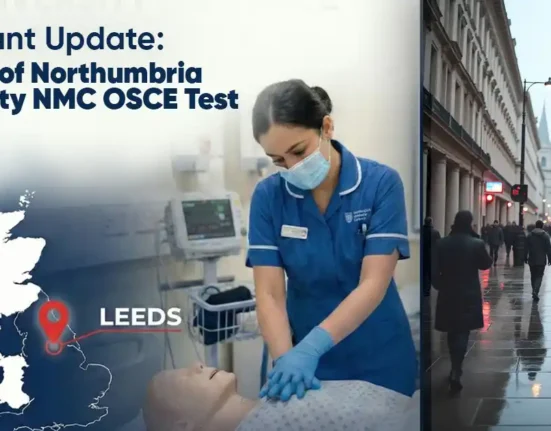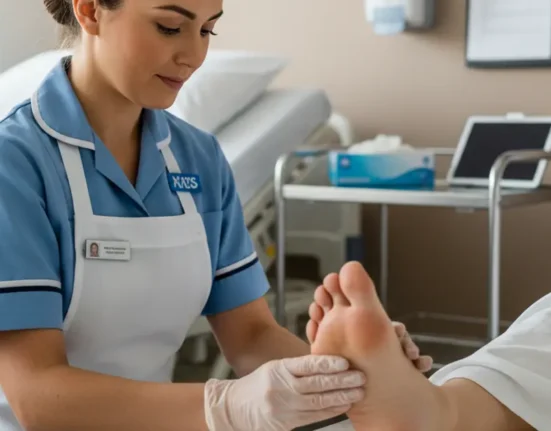The A–E assessment in NMC OSCE is a method used in NMC OSCE to effectively assess patients’ conditions, particularly their vital signs.
This structured approach—Airway, Breathing, Circulation, Disability, Exposure—ensures that life-threatening problems are identified and managed in order of priority. The A–E assessment format applies to all scenarios of NMC OSCE.
Let’s explore A–E assessment in detail
A is for Airway
The first step is ensuring the patient’s airway is open and protected. Without a clear airway, oxygen cannot reach the lungs, and the patient is at immediate risk.
Key Assessments:
- Is the patient able to speak with a normal voice in full sentences?
- Are there signs of airway obstruction?
B is for Breathing
Once the airway is open, the next priority is to assess whether the patient is breathing effectively. Inadequate breathing leads to insufficient oxygen reaching the tissues, which can rapidly result in organ failure.
Key Assessments:
- Respiratory rate: Check respiratory rate for full 1 minute and observe rhythm and depth as well
- Chest movement: Equal bilateral chest expansion.
- Respiratory sounds: Check for any sound like rattle, wheeze, stridor, or coughing: Rattling noises can indicate secretion, and stridor can indicate partial airway obstruction.
- Oxygen saturation (SpO₂): Measured with an oximeter.
- Signs of respiratory distress: Cyanosis, use of accessory muscles, sweating, ‘see-saw’ breathing:
1. Cyanosis- In this condition, because of a shortage of oxygen, the color of skin, lips, and nail beds turns bluish or purple.
2. Seesaw breathing- It occurs when the diaphragm moves in the opposite direction while inhaling and exhaling.
3. Use of accessory muscle- In regular breathing, accessory muscles are not active. However, it may be active while taking deep breathing.
C is for Circulation
The third step is to evaluate the effectiveness of the patient’s circulatory system. Is the heart pumping blood efficiently to vital organs or not
Key Assessments:
- Heart rate and rhythm- Check heart rate for full 1 minute and observe rhythm and strength as well
- Blood pressure- Monitoring systolic blood pressure and diastolic blood pressure. Systolic blood pressure is the top number that refers to the amount of pressure experienced by the arteries while the heart is beating. Diastolic blood pressure is the bottom number that refers to the pressure in the arteries while the heart rests between heartbeats.
- Capillary refill time (should be <2 seconds)- it indicates good peripheral perfusion
- Pallor and Perfusion- For perfusion, we observe hands and fingers color. Pink and warm indicates good peripheral circulation. Blood perfusion is vital for normal tissue physiology. And is responsible for transporting oxygen, nutrients, and waste products. Check for paleness, which may result from the decreased red blood cells.
D is for Disability
“Disability” refers to a rapid assessment of the patient’s consciousness, pain status, Urine output, and blood glucose value.
Key Assessments:
- Level of consciousness: Use the ACVPU scale (Alert, Confusion, responds to Voice, Pain, or Unresponsive).
- Pain- Ask about the pain status to the patient
- Urine output- Confirm with the patient if there is any problem while voiding urine.
- Blood glucose—Ask the patient about the last blood glucose reading.
E is for Exposure
Finally, the patient must be fully examined to identify any hidden injuries, rashes, or signs of infection. This also involves checking the patient’s core body temperature and past medical history.
Key Assessments:
- Check past medical history of scenario, acknowledge, and ask about any other medical condition to address.
- Look for signs of bleeding, infection, or rashes.
- Assess forehead and then monitor temperature.
Why the A–E Assessment Matters
Carrying out A–E assessment in a holistic approach is key to success for the NMC OSCE assessment station. The assessment aims to obtain a comprehensive picture of the patient’s condition and vital signs. It helps identify monitoring requirements and further care needs.
The A–E framework helps healthcare professionals identify and treat the patient’s conditions. Mastering the A–E assessment method is essential for NMC OSCE.
NMC OSCE For nurses Everything You Need to Know in 2025 Click Here
For Any NMC OSCE Related Queries and Training Chat with Us!











